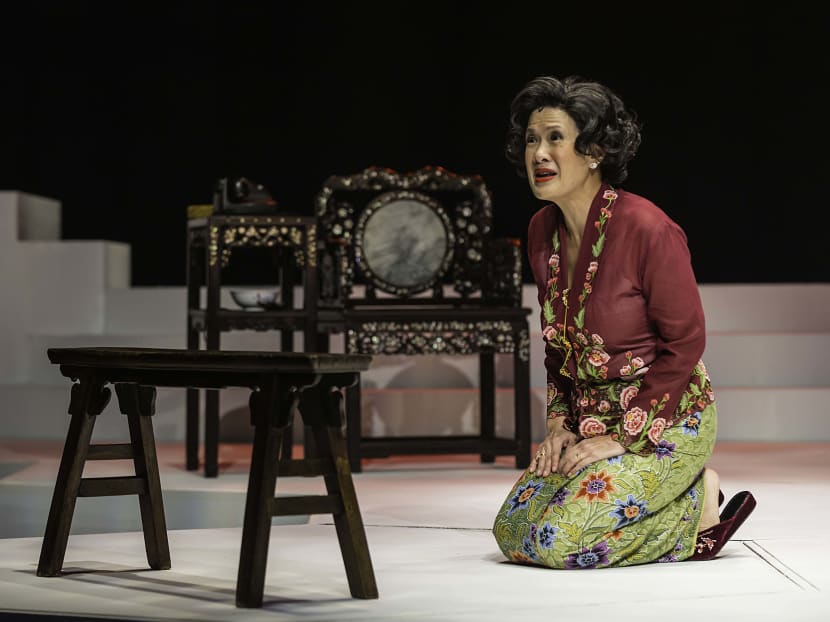Emily meets us halfway down the Hill
SINGAPORE — The visual arts may have come out with the first big SG50 event in LASALLE’s Institute of Contemporary Arts’ Artists Imagine A Nation last February, but theatre is making up for lost time by getting into the mood in a huge way this month.
SINGAPORE — The visual arts may have come out with the first big SG50 event in LASALLE’s Institute of Contemporary Arts’ Artists Imagine A Nation last February, but theatre is making up for lost time by getting into the mood in a huge way this month.
There’s the exhibition Theatre Memories: 50 Years Of Singapore Theatre at The Arts House. And then, of course, you’ve got the Esplanade’s special Studios season — which is practically a self-contained festival with five productions and a gazillion dramatised readings until May.
And it aptly kicks off with the scene’s ultimate success story — Stella Kon’s 1982 monologue Emily Of Emerald Hill has been staged 500 times since Leow Puay Tin first donned the kebaya in 1984. A handful of other performers have since stepped into the shoes of Peranakan matriarch Emily Gan to show off babi buah keluak cooking skills and quilt-sewing skills, relive heartbreaking moments with husband and son, and basically recount and embody her rise and fall.
In this version, director Alin Mosbit and performer Karen Tan convince Emily it’s time to get real and meet us halfway down the Hill.
To be honest, I’ve never been fond of the woman. For sure, she’s quite mesmerising to watch from a distance — as we’ve seen in the riveting performances not-so-long-ago by Margaret Chan and Ivan Heng. But as someone to have tea with? Nah, I’ll pass.
In contrast to the feisty, melodramatic presence of Chan’s and the self-consciously performative flamboyance of Heng’s, Tan’s Emily is a softie. More favourite aunt than colourful character, she seems, well, human.
One of the things that strikes me in this version is how, despite being a monologue, you don’t feel she’s alone. In the imagined interaction with family, friends and other Emerald Hill inhabitants, Tan’s Emily feels like she’s *among* them (as she walks through the wet market, scolds her sons, etc), as opposed to these invisible, mute characters being more or less “sounding boards” that previously fuelled Chan’s and Heng’s larger-than-life, stage-conquering performances.
This “approachability” is linked to one other difference. I’ve always been wary of the class position of Emily Of Emerald Hill. The privileged lives of a Peranakan family that seemed to exist in a bubble surrounded by invisible, voiceless people. There seems less of that bubble here precisely because her place in society feels more acknowledged (not to mention certain self-critical moments that admit to the sillier aspects of her world, such as the OTT shifts in accent and language when she deals with the common folks at the wet market and the expats at Cold Storage).
I’m also getting the not-quite-about-class vibes because this version has family emerging as its dominant theme. I’ve primarily read the story of Emily Of Emerald Hill as one commentary on societal change and modernity versus tradition, where the passing of family members was just another piece in the puzzle.
Here, these painful, poignant — and ultimately more familiar and relatable — relationships and issues are at the forefront. Again, this could perhaps be at the expense of that survive-at-all-costs tragic and all-encompassing portrait of the Peranakan woman. But I certainly don’t mind.
Make no mistake, performing Emily is tough (and this one has no intermission). Tan’s last one-woman show, if I remember correctly, was 2011’s exhausting-looking, multiple-character To Whom It May Concern, but fleshing out a character like Emily probably entails a different set of demands.
On opening night at least, Tan seemed to rush through her lines in the early stages. As the show went on, she would eventually settle in and seem more at ease. Fave moments are when her Emily would reveal an impish side (at parties, for instance) or a fragile tenderness (when she remembers her son while making ice cream). The image of her wrapped up majestically in a huge quilt, comprising pieces that each tell a different story, is a memorable one.
There are a couple of things I’m not too crazy about, though. The use of little flourishes of sound and light somewhat distracts from the piece itself.
Meanwhile the continuous transition between past and present moments are sometimes confusing and could perhaps be more fluid — I wonder, too, if the lack of clarity plays a part in the fact that there seems little sense of Emily going through that ageing process and being worn down by the years.
Before the show, I was wondering where it could take Emily Of Emerald Hill after Chan’s and Heng’s respective reach-for-the-stars approach. How do you top *those* right? Well, as Tan and Alin show, there’s a different route, one that stays closer to the ground, well within reach.
(Emily Of Emerald Hill is sold out. For more info, visit http://www.thestudios.com.sg. Meanwhile, BooksActually has set up a pop-up store featuring published plays by Singapore playwrights. These will be outside the Esplanade’s Theatre Studio and Recital Studio an hour before the performances and readings. And if your thirst for theatre becomes quite literal, Orgo has been concocting themed cocktails, such as Pink Matriarch (for Emily Of Emerald Hill).









